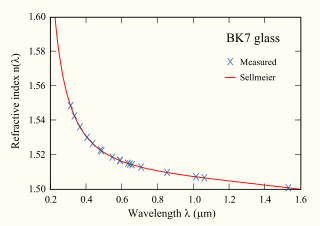Top Qs
Timeline
Chat
Perspective
Sellmeier equation
Empirical relationship between refractive index and wavelength From Wikipedia, the free encyclopedia
Remove ads
The Sellmeier equation is an empirical relationship between refractive index and wavelength for a particular transparent medium. The equation is used to determine the dispersion of light in the medium.


It was first proposed in 1872 by Wolfgang Sellmeier and was a development of the work of Augustin Cauchy on Cauchy's equation for modelling dispersion.[1]
Remove ads
Description
Summarize
Perspective
In its original and the most general form, the Sellmeier equation is given as
- ,
where n is the refractive index, λ is the wavelength, and Bi and Ci are experimentally determined Sellmeier coefficients. These coefficients are usually quoted for λ in micrometres. Note that this λ is the vacuum wavelength, not that in the material itself, which is λ/n. A different form of the equation is sometimes used for certain types of materials, e.g. crystals.
Each term of the sum representing an absorption resonance of strength Bi at a wavelength √Ci. For example, the coefficients for BK7 below correspond to two absorption resonances in the ultraviolet, and one in the mid-infrared region. Analytically, this process is based on approximating the underlying optical resonances as dirac delta functions, followed by the application of the Kramers-Kronig relations. This results in real and imaginary parts of the refractive index which are physically sensible.[2] However, close to each absorption peak, the equation gives non-physical values of n2 = ±∞, and in these wavelength regions a more precise model of dispersion such as Helmholtz's must be used.
If all terms are specified for a material, at long wavelengths far from the absorption peaks the value of n tends to
where εr is the relative permittivity of the medium.
For characterization of glasses the equation consisting of three terms is commonly used:[3][4]
As an example, the coefficients for a common borosilicate crown glass known as BK7 are shown below:
For common optical glasses, the refractive index calculated with the three-term Sellmeier equation deviates from the actual refractive index by less than 5×10−6 over the wavelengths' range[5] of 365 nm to 2.3 μm, which is of the order of the homogeneity of a glass sample.[6] Additional terms are sometimes added to make the calculation even more precise.
Sometimes the Sellmeier equation is used in two-term form:[7]
Here the coefficient A is an approximation of the short-wavelength (e.g., ultraviolet) absorption contributions to the refractive index at longer wavelengths. Other variants of the Sellmeier equation exist that can account for a material's refractive index change due to temperature, pressure, and other parameters.
Remove ads
Derivation
Summarize
Perspective
Analytically, the Sellmeier equation models the refractive index as due to a series of optical resonances within the bulk material. Its derivation from the Kramers-Kronig relations requires a few assumptions about the material, from which any deviations will affect the model's accuracy:
- There exists a number of resonances, and the final refractive index can be calculated from the sum over the contributions from all resonances.
- All optical resonances are at wavelengths far away from the wavelengths of interest, where the model is applied.
- At these resonant frequencies, the imaginary component of the susceptibility () can be modeled as a delta function.
From the last point, the complex refractive index (and the electric susceptibility) becomes:
The real part of the refractive index comes from applying the Kramers-Kronig relations to the imaginary part:
Plugging in the first equation above for the imaginary component:
The order of summation and integration can be swapped. When evaluated, this gives the following, where is the Heaviside function:
Since the domain is assumed to be far from any resonances (assumption 2 above), evaluates to 1 and a familiar form of the Sellmeier equation is obtained:
By rearranging terms, the constants and can be substituted into the equation above to give the Sellmeier equation.[2]
Remove ads
Coefficients
See also
References
External links
Wikiwand - on
Seamless Wikipedia browsing. On steroids.
Remove ads














